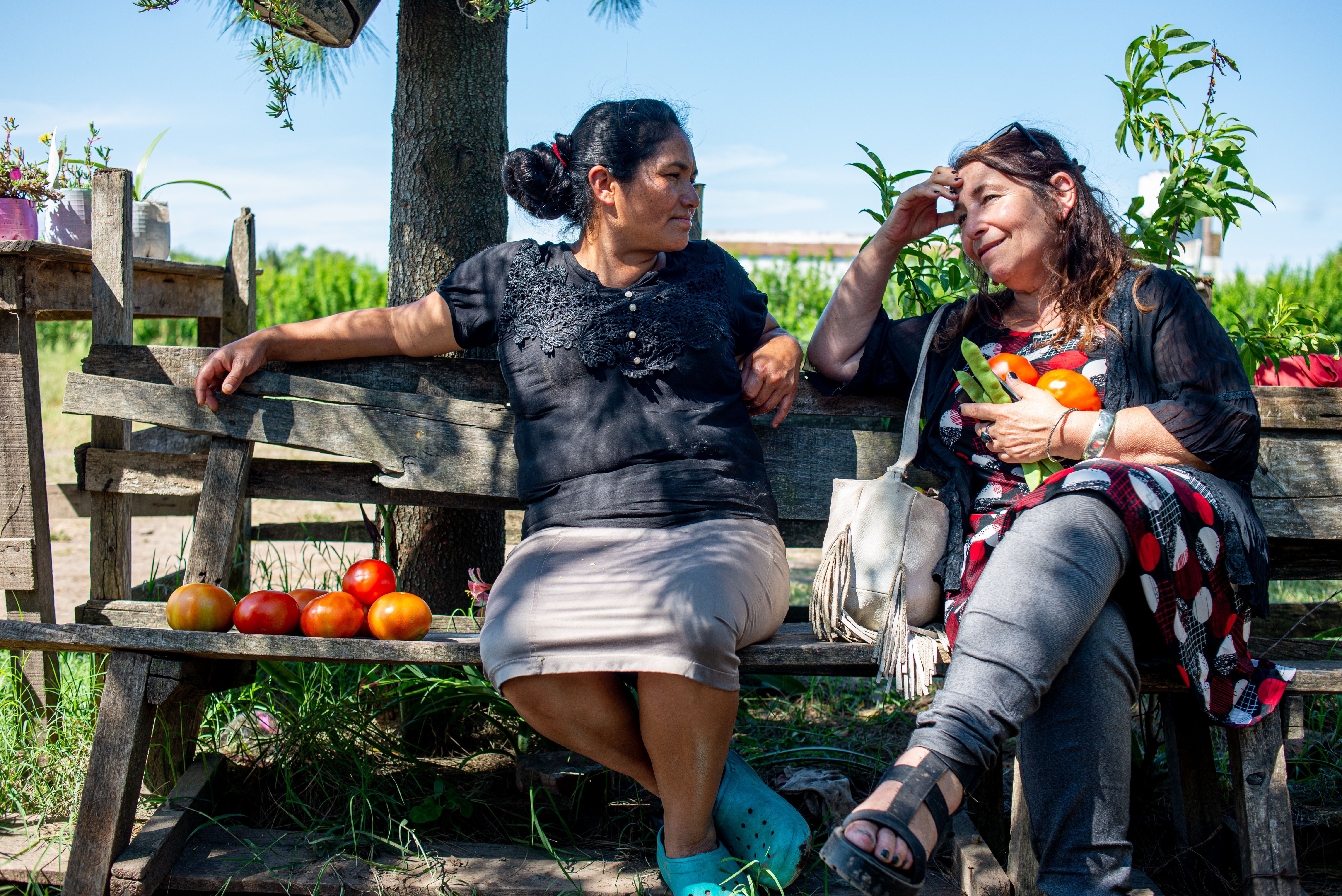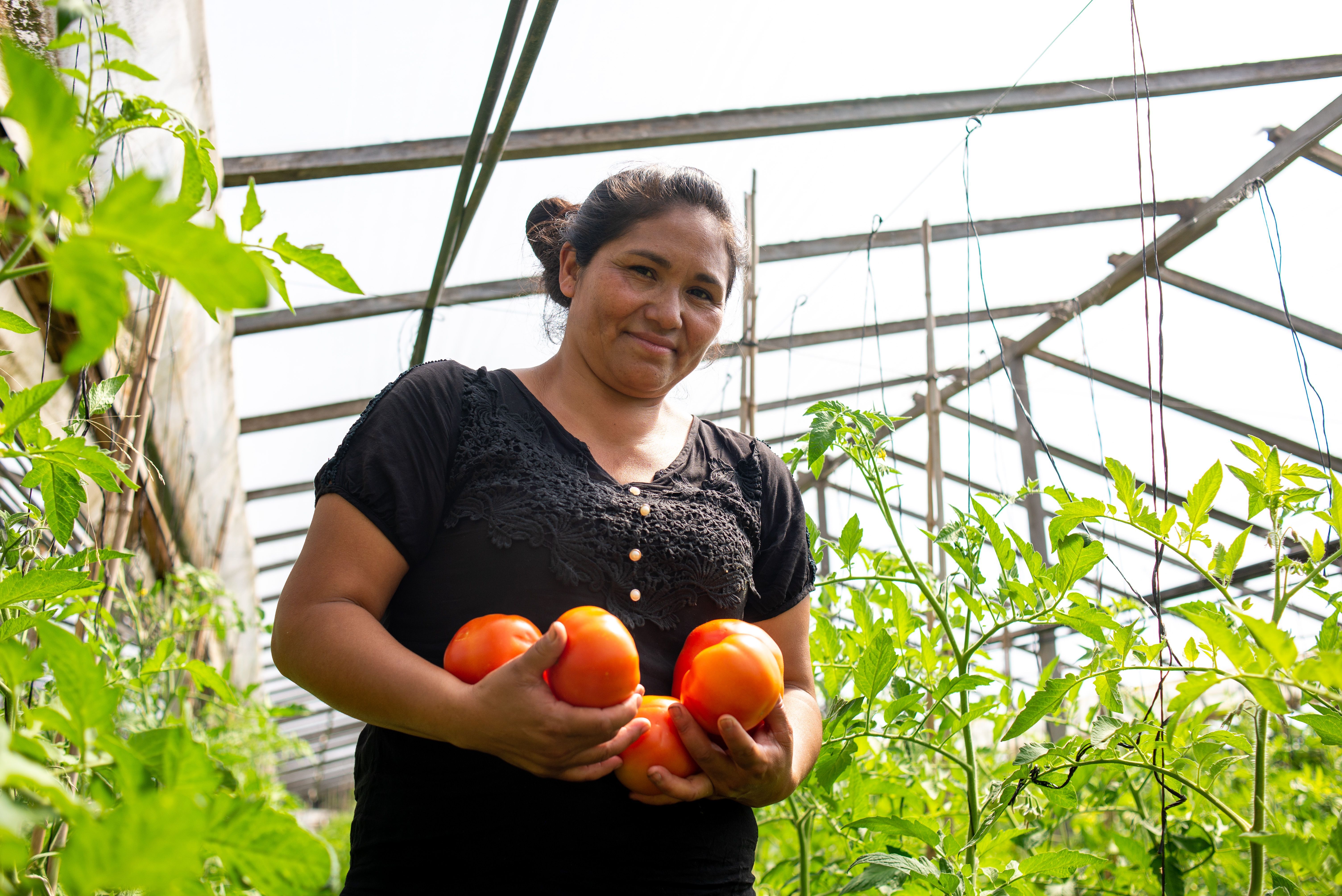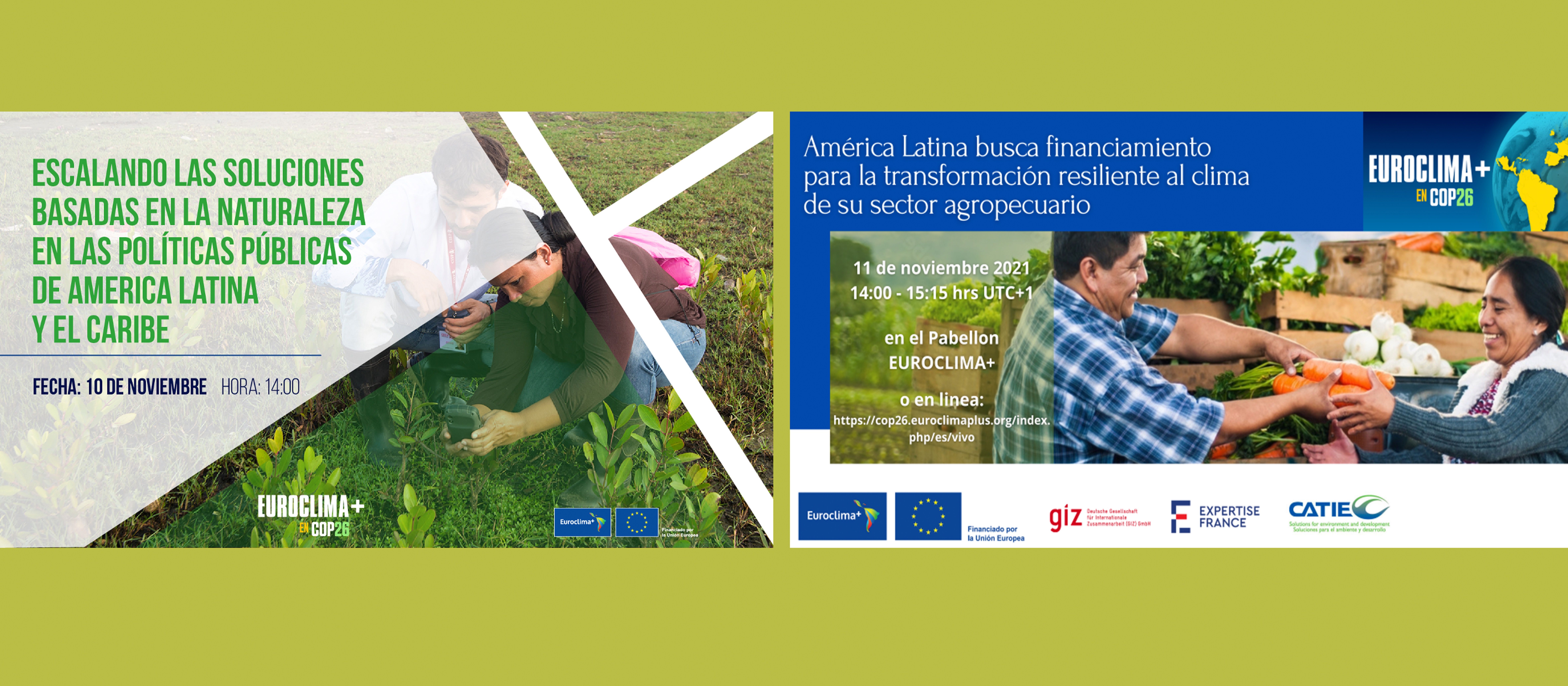5 June 2021, Argentina - On International Environment Day, we share the story of Sandra Cruz, a horticultural producer from La Plata. The text is a preview of the chronicles produced by the project 5 Resilient Food Production in horticultural-livestock systems of family farming in climatically vulnerable regions of Argentina and Colombia, of the Resilient Food Production sector of the EUROCLIMA+ programme.
Sandra Cruz still remembers the storm in February. The wind suddenly appeared and in a gust that was as unexpected as it was violent, it blew the nylons off all the greenhouses, swept away the poles and collapsed the structure of the sheds full of summer crops. In a few minutes, nothing was left. "We were ruined and we had no way to start again". Weather tragedies have a loyalty to the calendar. Sandra Cruz has the mark of that 5th of February, the blowing of the wind with gusts of 100 km/h, the furious dance of the nylons flying and tearing through the skies of the farms. She also remembers the electricity, which was cut off for hours, days, weeks. Of the generator that never arrived, because there was no money to pay for it. And also the image of the nothingness that followed, when the harvest was completely ruined and they had no way to start again.
The weather event affected the entire horticultural belt of Greater La Plata. With the partial - and in some cases total - destruction of structures under cover, vegetable crops and flowers suffered irreparable damage. This situation was compounded by the collapse of power lines (poles, wiring, transformers), with a direct impact on the functioning of the irrigation system, which generated additional losses on crops that, if the storm persisted, could not withstand the lack of irrigation due to a prolonged power outage.
In 2017, a one-hectare greenhouse, with its basic structure, cost approximately 1 million pesos. Losses exceeded 350 million, in addition to the crops affected by the lack of electricity supply after the climatic event. Pepper, eggplant and tomato crops grown under cover, without the greenhouse structure, suffered irreversible damage. The crop failure had a direct impact on the supply, volume and quality of fresh vegetables, which interrupted supplies.
The storm highlighted several issues: production conditions, access to land, the precariousness of the habitat, energy dependence. It also makes the intangible visible: dreams, hours, days, weeks, months of work, early mornings in the furrows, middays in the sun, waiting, guts, the future.
All of this swept away by a windstorm. And with the rain, hail and floods, it swept away thousands of vulnerable and precarious migrant families, most of them rentiers, who populate the productive fringes of the big cities and, in this case, feed more than 11 million inhabitants of the metropolitan area with their fresh vegetables.
 |
All this marks the 5th of February for Sandra Cruz, born in Bolivia more than four decades ago, who came to Argentina at the age of two, mother of six children, agroecological producer since the zero hour of that Aquarian month of 2017, sealed in her productive biography as the summer in which the greenhouses collapsed and in the depths of her spirit, dejected with all that the wind blew away, she said that this way, enough, this way, no. And she encouraged herself to do something else.
La Plata is the largest horticultural area in the country. Located in the peri-urban area of the southern metropolitan region of Buenos Aires, it supplies Argentina's main consumption centre, with a market of more than 11.5 million inhabitants. This area is a clear example of how urban-rural interfaces present tensions linked to the use of land and water, the availability of labour, the loss of resources and ecosystem services that are fundamental for the future, and the deterioration of the rural habitat and the urban edge. Matías García is a researcher at CONICET and has been studying the evolution of this horticultural sector for many years: "These are accelerated dynamics of change, which are aggravated by the scenarios of environmental crisis and climate change and are evidence of emerging socio-environmental and economic conflicts".
From his university chairs in La Plata and Florencio Varela, he describes how the productive model in La Plata is based on three pillars that make it competitive: the role of the Bolivian horticulturist, the exploitation of the workforce and greenhouse technology. He also analyses what he describes as negative externalities: "It is a system that suggests that the only way to resist or persist is by exacerbating the model: more inputs, more greenhouses, more exploitation. One of the adverse effects is on the environment: the impact of agrochemicals, the overexploitation of water, the loss of biodiversity. This generates more or less obvious impacts. One of the most noticeable impacts is seen in the increasingly frequent and furious storms. They tear down the greenhouses as if they were a house of cards. The way out of this vicious circle is neither easy nor simple, but it is necessary and evident that it is through agroecology, because of its effects on the environment, but also on the economy and the families who live and work in this sector. I don't know Sandra Cruz, but the history of this area is written with numerous Sandras. Her history is repeating itself".
Camila Gomez knows Sandra well. A long-time extension agent and current head of the AER La Plata, she has been visiting the family farms for years and describes the current production conditions: "For most family horticulturists, renting means a significant fixed cost that conditions the use of space and production rhythms. Tenants are forced to produce as much as possible in the shortest time available, with a very extractive use of soils and a high dependence on external inputs to guarantee productivity levels in relatively short periods of time".
 |
She explains that, in this way, the use of plastic covers, hybrid materials, poorly composted animal wastes, insecticides, fungicides, fertilisers and other similar synthetic chemical products, characterised the work of families in most of the horticultural belts and favoured numerous suppliers of inputs, credit (not always formal) and temporary financing.
-If this land were mine, I wouldn't have this need to produce, produce and produce to pay the rent," says Sandra Cruz. I have to have greenhouses to speed up production to pay the rent and electricity, as well as my children's schooling. If the land were mine, I wouldn't have so many greenhouses, I do it because I can't pay my bills.
When Sandra Cruz's entire farm collapsed in 2017 and the plastics blew away, she knew she had to do something else. She then approached a group of MTE producers and heard the word agroecology for the first time.
-What is that about? she asked at the first meeting. And what they told her filled her with curiosity.
-Will it work? she asked after a minute. And they said yes, it works.
- What if it fails and we lose everything? Her husband expressed reasonable doubts, since between the storm and the flat prices of the previous season, they were in no position to lose again.
Sandra is a good negotiator. And she prevailed: "We decided to try a little piece of land and it worked out.
From the INTA La Plata extension agency, Camila Gómez and her team propose agroecologically based management, through actions that favour the processes that occur naturally in the productive environment and that indirectly benefit the development of crops. "The aim is to think about the work in the farms from an ecological and integrative perspective that identifies the different components and resources present for their use," explains researcher Marisol Cuellas. With INTA and together with the EUROCLIMA+ Resilient Project, they promote the implementation of a soil management alternative that, in technical jargon, is called green manure: "it consists of sowing an association of fast-growing plant species to be incorporated into the soil in such a way that they favour organic matter, the release of nutrients, and increase or encourage microbial activity in the soil," explain Camila and Marisol in their workshops with producer families. They say that on Sandra's farm, the green fertilisers were implemented in an area under cover (greenhouse), affected by salinity conditions associated with extensive soil management and irrigation water conditions.
The practice of green manuring is a management alternative that is in line with the principles of agroecology and counteracts its negative effects. "We do this for the EUROCLIMA+ Resilient project, but also as an activity to incorporate new species such as sweet potato, carrot and potato. On the one hand, because they help to ensure the diversification demanded by consumers, but also to increase the diversity grown in the system, which can mean better sanitary management and less dependence on chemical use. The more diverse a system is, both in cultivated and spontaneous species, the greater the self-control or self-regulation of pests and diseases," they say. They say that, together with Sandra, they have also incorporated the use of biopreparations, with workshops and the testing of some organic ferments and mineral salts. "Recently, as a result of a Pro Huerta project, which set up the rural MTE biofactory, they isolated and multiplied trichodermas, which are soil fungi that favour the growth of horticultural species. These are indirect actions of isolation and multiplication of beneficial soil fungi that are carried out in the biofactory of the MTE and tested in Sandra's farm".
-Will it work?" Sandra Cruz asked herself four years ago, when the storm devastated her production and overturned a good part of her greenhouses. So she decided to try something else. Since then, she has been attending workshops, learning about biopreparations, green manures and boccachi. A new dictionary gave meaning to her pre-greenhouse knowledge. "Under cover everything is faster, in the field it's a bit easier, the rain helps with irrigation, the vegetables come out more rustic, it's true, but above all there is more help from nature".
- And why did you decide to do agroecology?
For the climate, for us, for our health, for our children.
About the project
"Resilientes" is a project implemented by INTA (Argentina) and CIPAV (Colombia), funded by the EUROCLIMA+ programme. The objective of Resilientes is to increase the adaptive capacity of 190 families in areas of high vulnerability to the negative effects of climate change. In Argentina in three locations: in Traslasierra (Córdoba), Northern Patagonia (Neuquén and Río Negro) and the Cinturón Hortícola Platense (La Plata - Bs.As.) and in the Caquetá region (Colombia). The life story of Sandra Cruz, a horticulturist from La Plata, is presented here. In this area, the Resilients Project works together with 50 horticultural families in the discussion, co-design and implementation of adaptation measures for the management of water, biodiversity and organisational strengthening.
More information:
This text and the accompanying video are an excerpt and preview of Resilient Stories. They were published here on 5 June, on Environment Day.
Area of Communication of INTA: This email address is being protected from spambots. You need JavaScript enabled to view it., This email address is being protected from spambots. You need JavaScript enabled to view it.
Resilient Food Production sector: This email address is being protected from spambots. You need JavaScript enabled to view it.
Photos and video: Paula Aguilera
See the video of the interview with Sandra Cruz:
